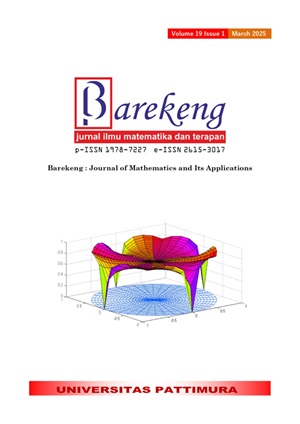VOLATILITY ANALYSIS AND INFLATION PREDICTION IN PANGKALPINANG USING ARCH GARCH MODEL
Abstract
One of the concerns of both developed and developing countries, as well as in a region, is the amount of inflation that occurs. Inflation is a serious problem. Inflation is a macroeconomic variable that affects people's welfare and is defined as a complex phenomenon resulting from general and continuous price increases. This research aims to analyze the volatility and projected value of the inflation rate, especially in Pangkalpinang City, using the Autoregressive Conditional Heteroskedasticity (ARCH) and Generalized Autoregressive Conditional Heteroskedasticity (GARCH) models. This research uses time series data on inflation rate of Pangkalpinang, Bangka Belitung Island Province from January 2014 to May 2024. This data was obtained through publications from the Central Statistics Agency of Bangka Beliltung Islands Province. The ARCH model is used to handle heteroscedasticity in data, while the GARCH model is a development of the ARCH model and serves as a generalization of the volatility model. This research shows that the predicted inflation rate in Pangkalpinang City from June 2024 to November 2024 tends to decrease with a MAPE prediction accuracy level of 200.04%. The high MAPE value is caused by actual data moving toward 0.
Downloads
References
Nugroho Arif Sudibyo, Ardymulya Iswardani, Arif Wicaksono Septyanto, and Tyan Ganang Wicaksono, “Prediksi Inflasi Di Indonesia Menggunakan Metode Moving Average, Single Exponential Smoothing Dan Double Exponential Smoothing,” J. Lebesgue J. Ilm. Pendidik. Mat. Mat. dan Stat., vol. 1, no. 2, pp. 123–129, 2020, doi: 10.46306/lb.v1i2.25.
A. Pebrianti, A. S. Utami, A. T. Putri, and A. Fitriana, “Proyeksi Laju Inflasi di Indonesia Dengan Metode ARIMA ( Autoregressive Integrated Moving Average ) Proyeksi Laju Inflasi di Indonesia Dengan Metode ARIMA ( Autoregressive Integrated Moving Average ),” ResearchGate, no. July, pp. 1–13, 2021.
A. Wahyuni, “Prediksi Nilai Inflasi Post Covid 19 di Indonesia,” Indones. J. Islam. Econ. Financ., vol. 2, no. 1, pp. 57–65, 2022, doi: 10.37680/ijief.v2i1.1606.
S. E. Y. Waluyo, K. Huda, M. J. Efendi, R. Sholeh, F. Budiyanto, and M. Ridha, “Study on The Impact of The Economic Recession and Global Crisis In 2023 on National Economic Resillience In Indonesia,” CERMIN J. Penelit., vol. 7, no. 1, pp. 291–305, 2023.
D. Y. Dalimunthe, “Data Forecasting Analysis of Gross Regional Domestic Product (Pdrb) As a Reject Measure of Economic Performance of Bangka Belitung Islands Province,” Integr. J. Bus. Econ., vol. 1, no. 1, pp. 19–27, 2017, doi: https://doi.org/10.5281/zenodo.322604.
D. Valeriani, R. S. Wardhani, D. Y. Dalimunthe, F. Hartini, and D. Reeve, “Infrastructure Readiness To Support Sustainable Tourism Destinations in Bangka Belitung Islands,” Int. J. Appl. Sci. Tour. Events, vol. 4, no. 1, p. 12, 2020, doi: 10.31940/ijaste.v4i1.1908.
M. Farid, “Krisis Politik dan Resesi Ekonomi Hong Kong (2019) dalam Perspektif Konstelasi Global dan Potensi Dampaknya Bagi Indonesia,” J. Kaji. Lemhannas RI, vol. 7, no. 4, pp. 35–50, 2019, [Online]. Available: https://prosiding.lemhannas.go.id/index.php/jkl/article/view/110/31.
S. Hasnanda and R. Ratna, “The Generalized Autoregressive Conditional Heteroscedasticity Model Application on Inflation and Consumers Price Index in Aceh,” J. Malikussaleh Public Econ., vol. 3, no. 1, p. 8, 2020, doi: 10.29103/jmpe.v3i1.3191.
R. P. Kurnia and A. A. Dzikrullah, “Volatilitas Harga Bawang Di Jawa Barat Dengan Metode Arch/Garch,” J. Lebesgue J. Ilm. Pendidik. Mat. Mat. dan Stat., vol. 3, no. 3, pp. 468–477, 2022, doi: 10.46306/lb.v3i3.153.
T. Gam, N. Nainggolan, and H. A. H. Komalig, “Analisis Volatilitas dan Peramalan Inflasi di Maluku Utara Menggunakan Model Generalized Autoregressive Conditional Heteroscedasticity (GARCH),” J. LPPM Bid. Sains dan Teknol., vol. 7, no. 2, pp. 8–18, 2022.
D. S. Lubis, “Analisis Nilai dan Ramalan Inflasi Dengan Metode Arch dan Garch,” At-tijaroh J. Ilmu Manaj. dan Bisnis Islam, vol. 2, no. 1, pp. 84–97, 2016, [Online]. Available: http://jurnal.iain-padangsidimpuan.ac.id/index.php/attijaroh/article/view/664.
R. M. Badu, “Pemodelan Harga Saham dengan pendekatan Model ARCH-GARCH,” p. 5, 2021.
G. Ardesfira et al., “JAMBURA JOURNAL OF PROBABILITY AND STATISTICS Volume 3 Nomor 2, November 2022,” vol. 3, no. November 2022, 2023.
A. W. Priyambodoi and Dyanasari, “Price Volatility of Shallot and Garlic and Effect on Inflation in East Java,” J. Agri Socio Econ. Bus., vol. 4, no. 2, pp. 109–118, 2022, doi: 10.31186/jaseb.4.2.109-118.
P. Puspitasari, D. Kurniasih, and A. M. Kiloes, “Aplikasi Model ARCH-GARCH dalam Menganalisis Volatilitas Harga Bawang Merah,” Inform. Pertan., vol. 28, no. 1, p. 21, 2019, doi: 10.21082/ip.v28n1.2019.p21-30.
I. A. Ula, “Pemodelan Volatilitas Harga Emas dan Kurs USD menggunakan Metode Constant Conditional Correlation Multivariate GARCH,” Universitas Islam Negeri Sunan Ampel, 2021.
F. C. Garini and W. Anbiya, “Application of GARCH Forecasting Method in Predicting The Number of Rail Passengers (Thousands of People) in Jabodetabek Region,” J. Mat. Stat. dan Komputasi, vol. 18, no. 2, pp. 198–223, 2022, doi: 10.20956/j.v18i2.18382.
A. B. Santoso, “Pahami heterokedastisitas dan cara mengatasinya,” 2021. .
S. Amar, A. Sudiarso, and M. K. Herliansyah, “The Accuracy Measurement of Stock Price Numerical Prediction,” J. Phys. Conf. Ser., vol. 1569, no. 3, 2020, doi: 10.1088/1742-6596/1569/3/032027.
R. Nurhamidah, “ANALISIS PERBANDINGAN INFLASI PERKOTAAN DAN PEDESAAN PADA GABUNGAN DUA KOTA DI PROVINSI KEPULAUAN BANGKA BELITUNG Rahma,” J. Empower. Community Educ., vol. 2, no. December 2021, pp. 423–443, 2022.
Copyright (c) 2025 Desy Yuliana Dalimunthe, Elyas Kustiawan, Khadijah -, Niken Halim, Helen Suhendra

This work is licensed under a Creative Commons Attribution-ShareAlike 4.0 International License.
Authors who publish with this Journal agree to the following terms:
- Author retain copyright and grant the journal right of first publication with the work simultaneously licensed under a creative commons attribution license that allow others to share the work within an acknowledgement of the work’s authorship and initial publication of this journal.
- Authors are able to enter into separate, additional contractual arrangement for the non-exclusive distribution of the journal’s published version of the work (e.g. acknowledgement of its initial publication in this journal).
- Authors are permitted and encouraged to post their work online (e.g. in institutional repositories or on their websites) prior to and during the submission process, as it can lead to productive exchanges, as well as earlier and greater citation of published works.






1.gif)



